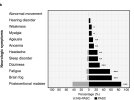Chandelier
Senior Member (Voting Rights)
Distinct brain alterations and neurodegenerative processes in cognitive impairment associated with post-acute sequelae of COVID-19
We analyzed blood proteins and brain MRI from individuals approximately one year after mild COVID-19, categorized as Cog-PASC (with cognitive impairment), Other-PASC (without cognitive impairment), or non-PASC controls, across exploration, covariate-matched, and independent validation cohorts.
In the exploration cohort, Cog-PASC showed elevated astroglial damage–associated proteins and structural and microstructural alterations across multiple cortical and subcortical regions, including cortical thinning in the cingulate and insular cortices, increased paramagnetic susceptibility in the hippocampus, and enlarged choroid plexus volume. In the age-, sex-, and education–matched cohort, cortical thinning and increased susceptibility in the cingulate remained significant.
Blood proteomics revealed broader alterations involving oxidative stress responses and synaptic function in Cog-PASC, linked to neurodegenerative pathways. In the validation cohort, increased neuronal and astroglial damage-associated proteins, cortical thinning in the cingulate and insular cortices, and increased hippocampal susceptibility were demonstrated, along with enlarged choroid plexus, confirming the reproducibility of these neurodegeneration-associated alterations.
These findings suggest distinct neurodegenerative processes in Cog-PASC not observed in other-PASC subtypes, even after mild COVID-19 infection.
Web | DOI | PDF | Nature Communications
Seo, Dayoung; Choi, Yangsean; Jeong, Eunseon; Bang, Sanghwi; Lee, Ji-Sung; Jang, In-Hye; Choi, Lynkyung; Kim, Jin Hee; Shin, Wangyoung; Seo, Bo-Ra; Kim, Shina; Jung, Hee-Jae; Kim, Ji-Yon; Kim, Hyunjin; Lim, Young-Min; Kwon, Ji-Soo; Chang, Euijin; Lee, Jacob; Kam, Tae-In; Park, Su-Hyung; Lee, Eun-Jae; Kim, Sung-Han
Abstract
Although brain alterations have been reported in post-acute sequelae of SARS-CoV-2 (PASC), their prevalence and relationship to neurodegeneration remain unclear.We analyzed blood proteins and brain MRI from individuals approximately one year after mild COVID-19, categorized as Cog-PASC (with cognitive impairment), Other-PASC (without cognitive impairment), or non-PASC controls, across exploration, covariate-matched, and independent validation cohorts.
In the exploration cohort, Cog-PASC showed elevated astroglial damage–associated proteins and structural and microstructural alterations across multiple cortical and subcortical regions, including cortical thinning in the cingulate and insular cortices, increased paramagnetic susceptibility in the hippocampus, and enlarged choroid plexus volume. In the age-, sex-, and education–matched cohort, cortical thinning and increased susceptibility in the cingulate remained significant.
Blood proteomics revealed broader alterations involving oxidative stress responses and synaptic function in Cog-PASC, linked to neurodegenerative pathways. In the validation cohort, increased neuronal and astroglial damage-associated proteins, cortical thinning in the cingulate and insular cortices, and increased hippocampal susceptibility were demonstrated, along with enlarged choroid plexus, confirming the reproducibility of these neurodegeneration-associated alterations.
These findings suggest distinct neurodegenerative processes in Cog-PASC not observed in other-PASC subtypes, even after mild COVID-19 infection.
Web | DOI | PDF | Nature Communications

